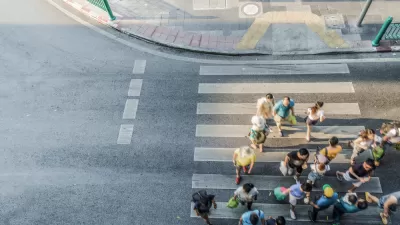Having launched a pedestrian safety campaign focused on education, legislators may go a step further to tackle another 'E'—enforcement. But rather than drivers, pedestrians looking down at their smart phones will be the targets.
"The proposed legislation was introduced the same month that a safety program* was expanded to include warnings against distracted driving and walking, as safety officials and lawmakers try to keep up with technology that increasing demands our attention," writes Larry Higgs, commuting reporter for NJ Advance Media for NJ.com.
The bill would fine pedestrians $50, if they are found guilty of using a handheld phone or texting while crossing the street. The legislation was proposed by Assemblywoman Pamela Lampitt, D-Camden, who cited a national increase in collisions between cars and pedestrians who were using phones while walking, as the reason for the bill.
Pedestrian safety is a topic near and dear to the heart of Planetizen. No other mode of transportation is so critical to the health and vibrancy of cities. Indeed, as the March report [PDF] of the Governors Highway Safety Association points out (posted here), pedestrian deaths are up while overall traffic deaths are down, though the National Safety Council indicates that all traffic deaths increased last year—in fact, the largest increase since such data was recorded.
The National Safety Council's Injury Facts®, which tracks data around the leading causes of unintentional injuries and deaths, contained information on "distracted walking" (posted here) last fall:
"Some data suggests that at any given moment on the streets of America, 60 percent of pedestrians are distracted while walking, meaning either on the phone or doing something on their phone,” said Alan S. Hilibrand of the American Academy of Orthopaedic Surgeons (AAOS). “It’s a bit of a startling number.
AAOS published a survey last December with more data on the "Perils of Walking While Under the Influence of Your Phone."
Lampitt's "bill carries the same penalty as jaywalking and half the fine would be allocated to safety education about the dangers of walking and texting," adds Higgs.
FULL STORY: OMG, lawmaker wants to ticket pedestrians who walk and text

Planetizen Federal Action Tracker
A weekly monitor of how Trump’s orders and actions are impacting planners and planning in America.

Maui's Vacation Rental Debate Turns Ugly
Verbal attacks, misinformation campaigns and fistfights plague a high-stakes debate to convert thousands of vacation rentals into long-term housing.

Restaurant Patios Were a Pandemic Win — Why Were They so Hard to Keep?
Social distancing requirements and changes in travel patterns prompted cities to pilot new uses for street and sidewalk space. Then it got complicated.

In California Battle of Housing vs. Environment, Housing Just Won
A new state law significantly limits the power of CEQA, an environmental review law that served as a powerful tool for blocking new development.

Boulder Eliminates Parking Minimums Citywide
Officials estimate the cost of building a single underground parking space at up to $100,000.

Orange County, Florida Adopts Largest US “Sprawl Repair” Code
The ‘Orange Code’ seeks to rectify decades of sprawl-inducing, car-oriented development.
Urban Design for Planners 1: Software Tools
This six-course series explores essential urban design concepts using open source software and equips planners with the tools they need to participate fully in the urban design process.
Planning for Universal Design
Learn the tools for implementing Universal Design in planning regulations.
Heyer Gruel & Associates PA
JM Goldson LLC
Custer County Colorado
City of Camden Redevelopment Agency
City of Astoria
Transportation Research & Education Center (TREC) at Portland State University
Jefferson Parish Government
Camden Redevelopment Agency
City of Claremont





























